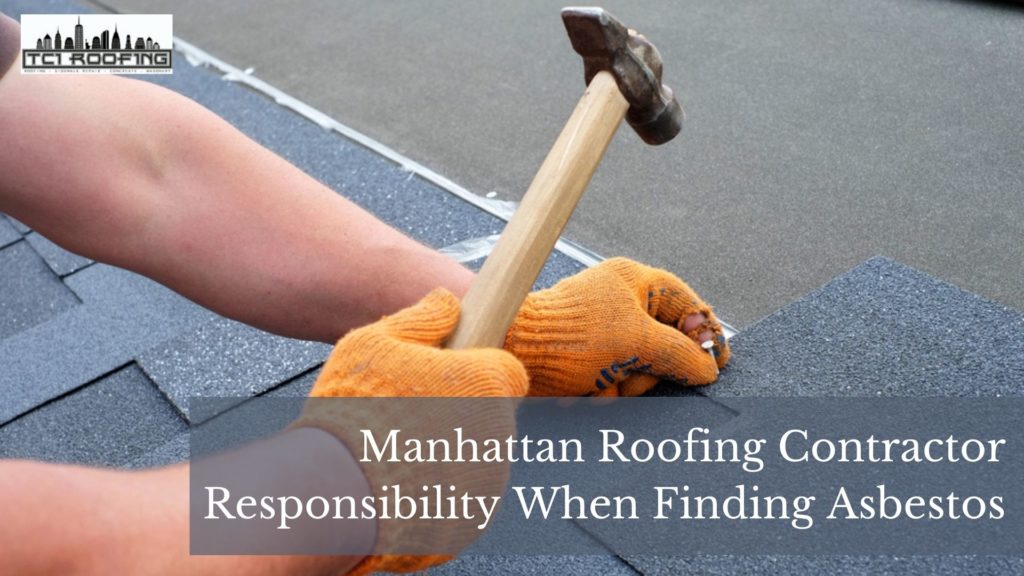In the roofing industry, roofers are responsible for checking their roofs for asbestos. Suppose you find it on your existing shingles. In that case, you will need to notify your roof installation company, which will have a certified asbestos abatement contractor come out and take care of the roofing project. This blog post will discuss how Manhattan roofing contractors can identify asbestos on the roof and what they should do when they find it.
What is Asbestos?
Roofing materials are also diverse. Pitch roofs employed multilayer asphalt roof shingles, while flat shingle roofs used tar with gravel stones. Almost all petroleum-based roofing materials once included hazardous asbestos fibers, regardless of roof design and roof system.
Asbestos fibers were once used to manufacture roofing materials to strengthen them, increase their longevity, and give a small degree of insulation and fireproofing. However, since the early 1980s, the usage of asbestos in roofing has steadily decreased.
What Are The Dangers of Asbestos Exposure?
Asbestos was employed in many items in the twentieth century because of its exceptional lightweight, resilient, affordable, insulating, and fireproofing material. For example, it was included in roofing goods to make them safer, which is hilarious.
Asbestos is widely known as a health danger, and its usage is now strictly regulated by OSHA and the Environmental Protection Agency. The asbestos fibers linked to these health concerns are too tiny to see with the naked eye. Asbestos fibers can cause asbestosis, a development of scar-like tissue in the lungs that leads to a loss of lung function and disability, and death. Asbestos also causes lung cancer and other disorders like mesothelioma of the pleura, a lethal malignant tumor of the membrane lining the lung or stomach cavity.
According to epidemiologic evidence, all asbestos fiber forms, including the most commonly used form of asbestos, chrysotile, induce mesothelioma in humans.
What Does OSHA Consider a Hazardous Level of Asbestos?
Specific OSHA guidelines for construction, general industrial, and shipyard employment sectors address worker exposure to asbestos dangers. These regulations limit the danger to workers by mandating businesses to provide personal exposure monitoring to determine the risk and hazard awareness training for operations involving asbestos.
Asbestos levels in the air should never exceed regulatory worker exposure guidelines. For any asbestos fiber, there is no “safe” degree of asbestos exposure. Humans have developed mesothelioma after being exposed to asbestos for as little as a few days.
Every workplace exposure to asbestos has the potential to cause harm or disease, and every occupational exposure to asbestos increases the likelihood of developing an asbestos-related disease. Therefore, employers must further protect workers exposed by establishing regulated zones, limiting specific work practices, and implementing engineering measures to reduce airborne levels.
The employer is responsible for ensuring that exposure is minimized through administrative controls and the provision of personal protective equipment. When regulatory limits and exposure times are surpassed, workers must be monitored medically.
What is The Role of The Competent Person?
According to OSHA, you must have a designated “competent person” on a job site where asbestos is suspected. According to OSHA, this person “is capable of identifying existing asbestos hazards in the workplace and select the appropriate control strategy for asbestos exposure” and “has the authority to take prompt corrective measures to eliminate” the asbestos.
As an employer, you must provide this person with the resources necessary to maintain the site secure. Therefore, OSHA demands specialized, extensive Environmental Protection Agency (EPA)-certified training for your authorized competent person.
If you suspect asbestos on the job site, you must allow this person to inspect it and collect objective data. This will either demonstrate that there is no danger (a Negative Exposure Assessment (NEA)) and that exposure is below the PEL, or the inspection will find that the threat is serious enough to warrant remediation (a Positive Exposure Assessment (PEA). Employers must keep meticulous records of any asbestos-related incidents in the workplace.
What Kind of Recordkeeping is Required For a Job With an Asbestos Hazard?
Employers are required to keep three types of asbestos-related records:
Exposure Monitoring
Employee exposure monitoring records must be kept for at least 30 years. The roofing material monitored, the amount of exposure, the techniques of analysis, the number of samples, and the names, Social Security numbers, and exposure levels of the personnel engaged are all included in these extensive records.
Medical Surveillance
Medical surveillance records for workers must be kept for the life of their employment plus further 30 years.
Training
Any training records must be preserved for a year after the employee’s last day of work.
You have a legal obligation to make these records available to the employees, their representatives, and OSHA when they ask for them.
Thoughts
Employers are responsible for a variety of tasks involving hazardous materials. For example, if asbestos is discovered on your job site, you must use warning signs to restrict the area. You must also provide a respirator to anyone approaching the area and inform other contractors on-site of the dangers.
You, as the contractor, are responsible for limiting exposure and eliminating dangers. If you’re working with a general contractor, they will be in charge of managing the project and will be able to enforce compliance.
While it may appear impossible to reduce and eliminate the risk of asbestos exposure, assistance is available. For example, the National Roofing Contractors Association (NRCA) created a checklist for workers who might come into contact with asbestos-containing construction materials. On the OSHA website, you may find these and other tools, as well as information on consultation services.
Suppose you’re looking for a roof installation near you for your new shingles, roof replacement on your asphalt shingles, or any of your roofing needs. We at TCI Manhattan are the best roofing company, and we’ve been doing asphalt shingle installation and new roof installation for 20 years. We always make sure that your roofs are safe and properly installed. Contact us today!

